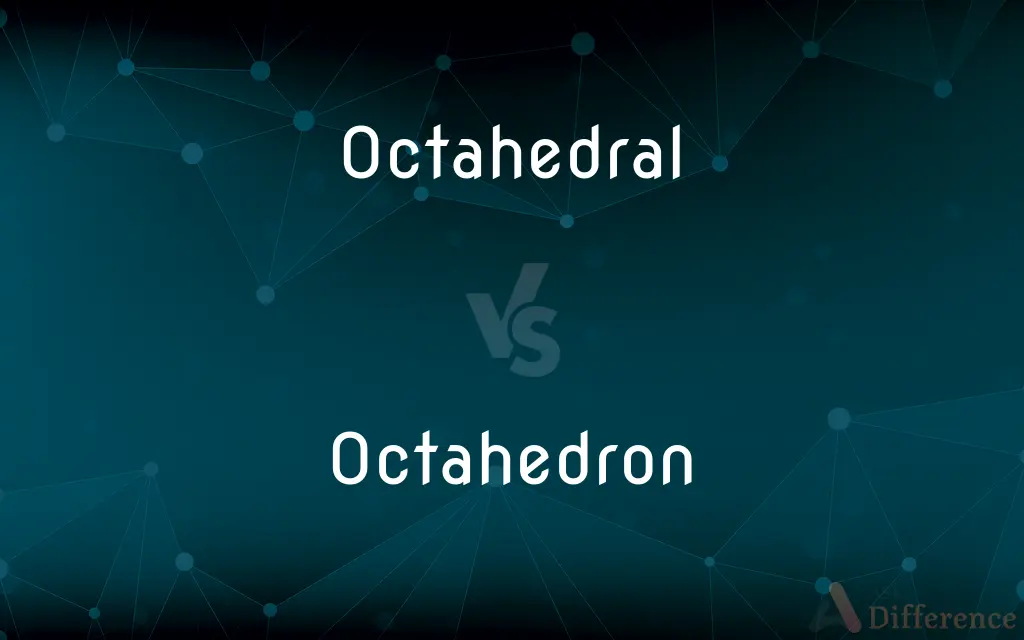Octahedral vs. Octahedron — What's the Difference?
By Urooj Arif & Fiza Rafique — Updated on March 28, 2024
An octahedral refers to having eight faces, often seen in molecular geometry, while an octahedron is a specific type of polyhedron with eight faces, commonly a regular solid.

Difference Between Octahedral and Octahedron
Table of Contents
ADVERTISEMENT
Key Differences
An octahedral shape is commonly associated with the spatial arrangement of atoms around a central atom in chemistry, especially in molecular geometry. This configuration involves six atoms or groups of atoms symmetrically spaced around a central atom, forming eight faces. On the other hand, an octahedron is a geometric solid, one of the five Platonic solids, characterized by having exactly eight faces, all of which are equilateral triangles.
While the term "octahedral" describes a type of symmetry or shape found in various contexts such as crystals and molecules, indicating a specific spatial arrangement, an octahedron refers to a precise geometric figure with defined properties, including vertices, edges, and angles. Whereas an octahedron is a mathematical abstraction often used in geometry and architectural design.
In crystallography and mineralogy, the octahedral shape is crucial for understanding the arrangements of atoms in crystals and the bonding nature of minerals. This concept is not limited to theoretical aspects but has practical implications in identifying and classifying minerals. Conversely, the study of octahedrons is essential in fields like mathematics, where it helps in exploring properties of three-dimensional shapes and in solving problems related to geometry and topology.
The octahedral arrangement is also significant in the field of coordination chemistry, where it describes the geometric layout of ligands attached to a central metal atom in a coordination complex. This arrangement influences the chemical reactivity and properties of the complex. In contrast, the concept of an octahedron is employed in art and architecture for its aesthetic appeal and structural efficiency, showcasing how theoretical shapes can influence practical and creative endeavors.
While "octahedral" is primarily used as an adjective to describe the shape or symmetry of objects, including molecules and crystal structures, the term "octahedron" is a noun that names a specific three-dimensional figure. This difference highlights how the two terms are applied in various scientific and mathematical contexts to describe shape, geometry, and spatial arrangement.
ADVERTISEMENT
Comparison Chart
Definition
Describes a shape or symmetry with eight faces, especially in molecular geometry.
A polyhedron with exactly eight faces, typically equilateral triangles.
Usage
Used as an adjective.
Used as a noun.
Fields of Application
Chemistry, crystallography, mineralogy.
Mathematics, geometry, art, architecture.
Relationship to Platonic Solids
Not a Platonic solid itself but refers to the spatial arrangement resembling one.
One of the five Platonic solids.
Example Context
Describes the geometric arrangement of atoms around a central atom.
Describes a specific geometric figure used in theoretical and practical contexts.
Compare with Definitions
Octahedral
Describing a molecular shape with a central atom surrounded by six others in a symmetrical arrangement.
SF6 molecule has an octahedral geometry.
Octahedron
A polyhedron with eight faces, all of which are equilateral triangles.
A regular octahedron is a common example used in geometry classes.
Octahedral
Used in describing the coordination environment of a central atom in a compound.
In coordination complexes, a central metal atom often adopts an octahedral coordination.
Octahedron
A solid figure in geometry that belongs to the Platonic solids.
The octahedron stands out among the Platonic solids for its symmetry.
Octahedral
Pertaining to the symmetry of a crystal having eight faces.
Some crystals exhibit octahedral symmetry due to their atomic arrangement.
Octahedron
Found in nature and art, symbolizing balance and aesthetic beauty.
Certain crystals naturally form in the shape of an octahedron.
Octahedral
Relating to any structure or object that resembles an octahedral shape.
Certain toy models can be constructed to showcase octahedral symmetry.
Octahedron
Utilized in architectural designs for its aesthetic and structural properties.
Some modern sculptures are based on the octahedron form.
Octahedral
Referring to the overall shape of an object that appears to have eight surfaces.
Certain types of dice are designed with an octahedral shape for uniformity.
Octahedron
In mathematics, it represents a case study for exploring properties of symmetry and polyhedra.
Studies on the octahedron help in understanding Euler's formula.
Octahedral
Having eight plane surfaces.
Octahedron
In geometry, an octahedron (plural: octahedra, octahedrons) is a polyhedron with eight faces, twelve edges, and six vertices. The term is most commonly used to refer to the regular octahedron, a Platonic solid composed of eight equilateral triangles, four of which meet at each vertex.
Octahedral
Having eight plane surfaces; thus, in the shape or form of an octahedron.
Octahedron
A polyhedron with eight faces.
Octahedral
Of, or pertaining to octahedra.
Octahedron
(geometry) a polyhedron with eight faces; the regular octahedron has regular triangles as faces and is one of the Platonic solids.
Octahedral
Having eight faces or sides; of, pertaining to, or formed in, octahedrons; as, octahedral cleavage; an octahedral crystal.
Octahedron
A solid bounded by eight faces. The regular octahedron is contained by eight equal equilateral triangles.
Octahedron
Any polyhedron having eight plane faces
Common Curiosities
How does an octahedron differ from other Platonic solids?
An octahedron differs by having exactly eight faces, all equilateral triangles, distinguishing it from other Platonic solids which have different numbers and types of faces.
Is the octahedral shape common in nature?
Yes, the octahedral shape is common in nature, particularly in crystal structures and molecular geometries.
What is an octahedral shape?
An octahedral shape refers to a spatial arrangement in which a central atom is surrounded by six other atoms or groups, resulting in a geometry with eight faces.
What fields study octahedrons?
Octahedrons are studied in mathematics, geometry, art, and architecture for their structural and aesthetic properties.
Can an octahedron have faces other than triangles?
In its regular form, an octahedron always has equilateral triangular faces, but in its irregular forms, the faces can vary in shape.
Can an object be both octahedral and an octahedron?
Yes, an object can be described as octahedral if it has an octahedron-like shape, but "octahedron" specifically refers to a geometric figure with eight triangular faces.
How do octahedrons contribute to geometric studies?
Octahedrons contribute to geometric studies by providing insights into three-dimensional symmetry, polyhedral theory, and topology.
How is the octahedral arrangement important in chemistry?
The octahedral arrangement is crucial in chemistry as it affects the properties and reactivities of molecules, especially in coordination compounds.
Are all octahedral molecules symmetric?
Yes, octahedral molecules are highly symmetric, with six atoms or ligands arranged around a central atom in a symmetrical fashion.
How do octahedral and octahedron concepts apply in education?
In education, these concepts are used to teach students about geometric shapes, molecular geometry, and the physical properties of materials.
Why are octahedrons significant in architecture?
Octahedrons are significant in architecture for their aesthetic appeal and structural efficiency, often used in designing innovative buildings and sculptures.
What is the significance of octahedral symmetry in crystals?
Octahedral symmetry in crystals is significant for understanding the arrangement of atoms and the physical properties of the crystal, such as hardness and cleavage.
Can the principles of octahedral geometry be applied in technology?
Yes, the principles of octahedral geometry find applications in technology, particularly in materials science, for designing molecules and materials with desired properties.
Do octahedrons appear in art?
Yes, octahedrons often appear in art due to their geometric beauty and symmetry, inspiring sculptures and installations.
What makes an octahedral coordination complex unique?
An octahedral coordination complex is unique due to its spatial arrangement that allows for specific interactions between the central metal atom and its ligands, influencing the complex's chemical behavior.
Share Your Discovery

Previous Comparison
Moto vs. Motto
Next Comparison
Actor vs. PerformerAuthor Spotlight
Written by
Urooj ArifUrooj is a skilled content writer at Ask Difference, known for her exceptional ability to simplify complex topics into engaging and informative content. With a passion for research and a flair for clear, concise writing, she consistently delivers articles that resonate with our diverse audience.
Co-written by
Fiza RafiqueFiza Rafique is a skilled content writer at AskDifference.com, where she meticulously refines and enhances written pieces. Drawing from her vast editorial expertise, Fiza ensures clarity, accuracy, and precision in every article. Passionate about language, she continually seeks to elevate the quality of content for readers worldwide.
















































